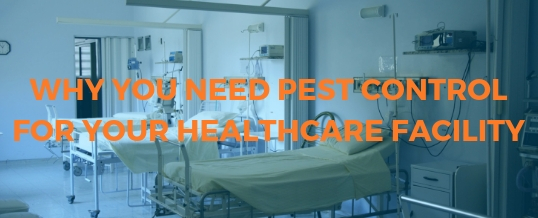
Healthcare facilities can have a lot of different areas that are inviting to pests — exam rooms, waiting areas, restrooms, and break rooms are some of the most common areas we see pest problems. And unfortunately, a pest infestation (or a reputation for pests) can discourage patients from visiting your facility. Presence of pests such as flies, rodents, and bed bugs ruin the reputation of healthcare facilities and affect quality of care.
What are the Common Pests found in Healthcare Settings?
There are various types of pests found in the healthcare setting. Some of the most common include:
1. Rodents
Rodents are among the most dangerous pests found in healthcare settings. They are not only unsightly to the patients but are capable of spreading a lot of disease. They pose a risk both to the patient and the hospital management.
As the rodents walk around, they carry pathogens causing diseases from one place to another. The unsanitary droppings they leave can lead to the contamination of food meant for patients and hospital staff. Some rodent droppings can cause harmful viruses when fresh rodent urine, droppings, or nesting materials are stirred up, causing tiny droplets containing virus to get into the air.
Aside from health issues, rodents also damage hospital equipment, products, and packaging. Rodents can effortlessly enter a healthcare facility without anyone’s knowledge. The rats and mice can get in through the open doors, the small cracks on walls, and holes, and packages in shipments.
2. Bedbugs
Bedbugs are pests that can cause discomfort to patients admitted to the hospitals. Since bedbugs are such small insects, it is hard for the hospital management to spot them easily. Bedbugs are prevalent in beds, pictures, furniture, cracks, and folds found in the bed.
The insects mostly feed on the blood of the patients occupying the hospital beds. It is possible for the bedbugs to spread in the healthcare setting due to their easy transferability. A patient can transfer bedbugs from their home to the hospital through their clothing or the luggage. It is crucial for hospitals to conduct regular bedbugs pest control practices.
3. Cockroaches
Cockroaches are resilient pests that can quickly develop into large infestations within a short period of time. Cockroaches are vectors capable of spreading bacteria such as salmonella and E-coli. Roaches can also contaminate food meant for patients and hospital staff.
Another adverse effect of cockroaches is that they trigger allergic reactions and asthma attacks in susceptible patients. Roaches are one of the most common pests around and it is easy for them to get into the healthcare setting.
4. Mosquitoes
Mosquitoes may not seem like a common pest for healthcare facilities, but they are found everywhere in the world and carry some of the worst diseases and pathogens. They’ll become active when the temps rise above 50 degrees (so mid Spring in Memphis) and mostly breed in the shallow waters, clogged gutters, decorative ponds, and fountains. If you have a serenity area for patients, it’s a good idea to regularly control for mosquitoes or it won’t be very serene for long!
5. Flies
Mostly irritating and annoying, flies can bring other problems. And they’re another pest that leads people to create a bad impression of your facility. According to the findings of the Center for Disease Control, flies can carry twice the amount of pathogens transmitted by cockroaches.
The medical facilities and clinics need to control for flies to prevent the spread of food-borne illness. Flies easily enter facilities through doors and windows. Flies also tend to be abundant in/near garbage and food areas — keeping these areas clean and clear will go a long way to keeping flies under control.
6. Ants
Ants move in massive populations within their colonies. They migrate from one region to another in search of food. Due to their changing diets, they are likely to take shelter in healthcare facilities, and certain ants are very attracted to foodstuffs and create problems with inventory. Although they do not tend to carry disease they are unsightly and you will have to get rid of some inventory and food if infested with ants.
Why is it Important to Control Pests in Healthcare Settings?
The primary goal of all healthcare facilities is to offer quality care and comfort to patients. Unfortunately, healthcare facilities are no different from any other building and they can be infested with pests as well. Obviously, a pest infestation in a healthcare facility is going to affect its reputation how the public and patients view the institution. If not handled properly it can also affect healthcare and outcomes for patients.
Healthcare settings can choose to handle their own pest control strategies or they can a hire a professional commercial pest control partner to handle the job for them. In most instances, a professional option is the best solution.
Tips on how to Control Pests in a Medical Facility or Clinic
Timely response to all pests is critical once you realize your facility has an infestation.
Pests such as cockroaches can multiply fast within a short time. A rapid response can prevent a small issue from turning into a major one. Ignoring a pest problem can lead to health violations and an eventual shutdown of your building. For this and other reasons, healthcare facility ought to take a proactive approach towards managing pests. It is crucial for hospitals to put in place protocols and integrated pest management practices. The presence of control measures will help ensure a timely and proper response to pest infestations.
Identifying risk factors, both internally and externally, is also critical. Understanding a facilities risk factors will enable the healthcare facility manager to plan and respond to any issue.
Pest control professionals have a high level of specialization and expertise that can help in effective pest control for healthcare environments.
If you need pest control services for your healthcare facility contact our professionals at Inman-Murphy — we have the experience and know-how to handle pest control problems in a healthcare setting and the professionalism to understand your patient’s welfare and confidentiality as well as health code compliance are of utmost importance. Contact us today for a free quote or to schedule a pest control evaluation and plan.





